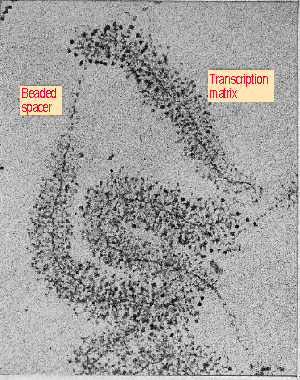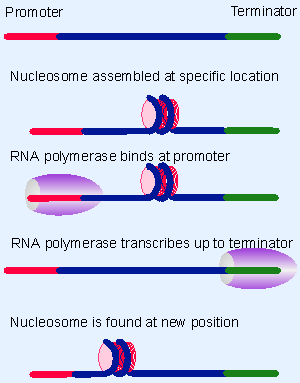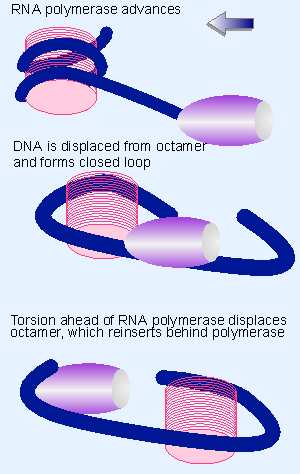10. Are transcribed genes organized in nucleosomes?
19.10 Are transcribed genes organized in nucleosomes? |
Attempts to visualize genes during transcription have produced conflicting results. The next two figures show each extreme.
 |
Figure 19.33 The extended axis of an rDNA transcription unit alternates with the only slightly less extended non-transcribed spacer. Photograph kindly provided by Charles Laird. |
Heavily transcribed chromatin can be seen to be rather extended (too extended to be covered in nucleosomes). In the intensively transcribed genes coding for rRNA, shown in Figure 19.33, the extreme packing of RNA polymerases makes it hard to see the DNA. We cannot directly measure the lengths of the rRNA transcripts because the RNA is compacted by proteins, but we know (from the sequence of the rRNA) how long the transcript must be. The length of the transcribed DNA segment, measured by the length of the axis of the "Christmas tree," is ~85% of the length of the rRNA. This means that the DNA is almost completely extended.
 |
Figure 19.34 An SV40 minichromosome can be transcribed. Photograph kindly provided by Pierre Chambon. |
On the other hand, transcription complexes of SV40 minichromosomes can be extracted from infected cells. They contain the usual complement of histones and display a beaded structure. Chains of RNA can be seen to extend from the minichromosome, as in the example of Figure 19.34. This argues that transcription can proceed while the SV40 DNA is organized into nucleosomes. Of course, the SV40 minichromosome is transcribed less intensively than the rRNA genes.
Transcription involves the unwinding of DNA, and may require the fiber to unfold in restricted regions of chromatin. A simple-minded view suggests that some "elbow-room" must be needed for the process. The features of polytene and lampbrush chromosomes described in 18 Chromosomes offer hints that a more expansive structural organization is associated with gene expression.
 |
Figure 19.35 RNA polymerase is comparable in size to the nucleosome and might encounter difficulties in following the DNA around the histone octamer. |
In thinking about transcription, we must bear in mind the relative sizes of RNA polymerase and the nucleosome. The eukaryotic enzymes are large multisubunit proteins, typically >500 kD. Compare this with the ~260 kD of the nucleosome. Figure 19.35 illustrates the approach of RNA polymerase to nucleosomal DNA. Even without detailed knowledge of the interaction, it is evident that it involves the approach of two comparable bodies.
Consider the two turns that DNA makes around the nucleosome. Would RNA polymerase have sufficient access to DNA if the nucleic acid were confined to this path? During transcription, as RNA polymerase moves along the template, it binds tightly to a region of ~50 bp, including a locally unwound segment of ~12 bp. The need to unwind DNA makes it seem unlikely that the segment engaged by RNA polymerase could remain on the surface of the histone octamer.
It therefore seems inevitable that transcription must involve a structural change. So the first question to ask about the structure of active genes is whether DNA being transcribed remains organized in nucleosomes. If the histone octamers are displaced, do they remain attached in some way to the transcribed DNA (for review see Kornberg and Lorch, 1992)?
One experimental approach is to digest chromatin with micrococcal nuclease, and then to use a probe to some specific gene or genes to determine whether the corresponding fragments are present in the usual 200 bp ladder at the expected concentration. The conclusions that we can draw from these experiments are limited but important. Genes that are being transcribed contain nucleosomes at the same frequency as nontranscribed sequences. So genes do not necessarily enter an alternative form of organization in order to be transcribed.
But since the average transcribed gene probably only has a single RNA polymerase at any given moment, this does not reveal what is happening at sites actually engaged by the enzyme. Perhaps they retain their nucleosomes; more likely the nucleosomes are temporarily displaced as RNA polymerase passes through, but reform immediately afterward.
 |
Figure 19.36 A protocol to test the effect of transcription on nucleosomes shows that the histone octamer is displaced from DNA and rebinds at a new position. |
Experiments to test whether an RNA polymerase can transcribe directly through a nucleosome suggest that the histone octamer is displaced by the act of transcription. Figure 19.36 shows what happens when an RNA polymerase transcribes a short piece of DNA containing a single octamer core in vitro. The core remains associated with the DNA, but is found in a different location. The core is most likely to rebind to the same DNA molecule from which it was displaced (Studitsky et al., 1994).
 |
Figure 19.37 RNA polymerase displaces DNA from the histone octamer as it advances. The DNA loops back and attaches (to polymerase or to the octamer) to form a closed loop. As the polymerase proceeds, it generates positive supercoiling ahead. This displaces the octamer, which keeps contact with DNA and/or polymerase, and is inserted behind the RNA polymerase. Animated figure |
Figure 19.37 shows a model for polymerase progression. DNA is displaced as the polymerase enters the nucleosome, but the polymerase reaches a point at which the DNA loops back and reattaches, forming a closed region. As polymerase advances further, unwinding the DNA, it creates positive supercoils in this loop; the effect could be dramatic, because each base pair through which the polymerase advances makes a significant addition to the supercoiling in a closed loop of ~80 bp. In fact, the polymerase progresses easily for the first 30 bp into the nucleosome. Then it proceeds more slowly, as though encountering increasing difficulty in progressing. Pauses occur every 10 bp, suggesting that the structure of the loop imposes a constraint related to rotation around each turn of DNA. When the polymerase reaches the midpoint of the nucleosome (the next bases to be added are essentially at the axis of dyad symmetry), pausing ceases, and the polymerase advances rapidly. This suggests that the midpoint of the nucleosome marks the point at which the octamer is displaced (possibly because positive supercoiling has reached some critical level that expels the octamer from DNA). This releases tension ahead of the polymerase and allows it to proceed. The octamer then binds to the DNA behind the polymerase and no longer presents an obstacle to progress. Probably the octamer changes position without ever completely losing contact with the DNA.
Is the octamer released as an intact unit? Crosslinking the proteins of the octamer does not create an obstacle to transcription. Transcription can continue even when crosslinking is extensive enough to ensure that the central regions of the core histones have been linked. This implies that transcription does not require dissociation of the octamer into its component histones, nor is it likely to require any major unfolding of the central structure. However, addition of histone H1 to this system causes a rapid decline in transcription. This suggests two conclusions: the histone octamer (whether remaining present or displaced) functions as an intact unit; and it may be necessary to remove H1 from active chromatin or modify its interactions in some way.
 |
Figure 19.38 The URA3 gene has translationally positioned nucleosomes before transcription. When transcription is induced, nucleosome positions are randomized. When transcription is repressed, the nucleosomes resume their particular positions. Photograph kindly provided by Fritz Thoma. |
The organization of nucleosomes may be changed by transcription. Figure 19.38 shows what happens to the yeast URA3 gene when it transcribed under control of an inducible promoter. The rate of transcription is high (overcoming the criticism that the target genes being characterized en masse may not actually be suffering an act of transcription). Positioning is examined by using micrococcal nuclease to examine cleavage sites relative to a restriction site at the 5′ end of the gene. Initially the gene displays a pattern of nucleosomes that are organized from the promoter for a significant distance across the gene; positioning is lost in the 3′ regions. When the gene is expressed, a general smear replaces the positioned pattern of nucleosomes. So, nucleosomes are present at the same density but are no longer organized in phase. This suggests that transcription destroys the nucleosomal positioning. When repression is reestablished, positioning appears within 10 min (although it is not complete). This result makes the interesting point that the positions of the nucleosomes can be adjusted without replication.
The unifying model is to suppose that RNA polymerase displaces histone octamers as it progresses. If the DNA behind the polymerase is available, the octamer reattaches there (possibly or probably never having ever totally lost contact with the DNA. It remains a puzzle how an octamer could retain contact with DNA, without unfolding or losing components, as an object of even larger size than itself proceeds along the DNA. Perhaps the octamer is "passed back" by making contacts with RNA polymerase). If the DNA is not available, for example, because another polymerase continues immediately behind the first, then the octamer may be permanently displaced, and the DNA may persist in an extended form.
| Reviews | |
| Kornberg, R. D. and Lorch, Y. (1992). Chromatin structure and transcription. Ann. Rev. Cell Biol. 8, 563-587. | |
| Research | |
| Studitsky, V. M., Clark, D. J., and Felsenfeld, G. (1994). A histone octamer can step around a transcribing polymerase without leaving the template. Cell 76, 371-382. | |